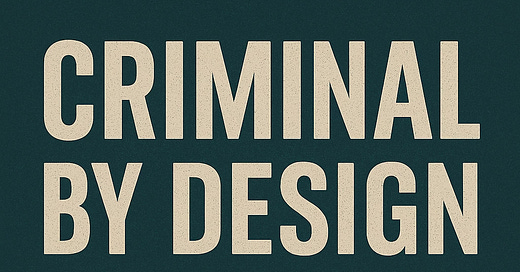CH 7 - Criminal by Design: How Illegality Is Manufactured
From Criminal by Design: The Architecture of Harm in U.S. Immigration
Listen to the podcast
Return to the Criminal by Design: The Architecture of Harm in U.S. Immigration Hub
In most narratives, the law is a line. You’re on one side or the other—legal or illegal, right or wrong.
But what if the line was drawn to trap you? What if "illegal" wasn’t a state of being—but a strategy?
For many immigrants, the journey into so-called illegality isn’t a moral failure. It’s a design feature of a system that makes compliance impossible, then criminalizes the result. This is not a flaw in enforcement. It’s a deliberate funnel—from desperation to punishment.
"It’s not that they broke the law. It’s that the law was built to break them."
The System Manufactures Illegality
The system doesn’t just punish undocumented immigrants. It produces them—by design.
For decades, U.S. immigration law has created categories of “legal” and “illegal” that often have little to do with justice or safety—and everything to do with control, labor exploitation, and political power.
Start with the bottleneck:
There are more than 10.5 million undocumented immigrants in the U.S. today.
Many entered legally and overstayed visas because they had no path to renew.
Others waited in vain through legal channels—some visa wait times exceed 20 years.
And still more fled danger, starvation, or disaster—only to be told that their suffering didn’t meet the strict legal categories of asylum.
"You are only illegal because we made it impossible for you to be legal."
Before 1929, crossing the U.S. border without papers wasn’t a criminal act. It was a civil infraction—similar to a parking ticket.
But with the rise of racialized enforcement (and later, the War on Drugs), the U.S. began criminalizing border crossings. Today:
First-time unauthorized entry is a misdemeanor, repeat entry is a felony.
Most asylum seekers are criminalized while trying to comply.
Thousands are charged before they can plead their case.
"In 2023, over 70,000 migrants were prosecuted for illegal entry—a 400% increase from a decade prior." (Source: TRAC Immigration)
A Business Model Built on ‘Illegality’
This isn’t about enforcement. It’s about economics.
Undocumented labor is profitable. Industries from agriculture to construction rely on immigrants who have no legal recourse and can be paid less with fewer protections.
Private prison and detention center contracts increase with each arrest. As of 2024, ICE holds over 35,000 people daily—costing taxpayers $150–$250 per person per day, generating billions in revenue for companies like CoreCivic and GEO Group.
Deportation quotas incentivize arrests. Internal memos have shown agents are pressured to meet targets, regardless of criminal activity.
And let’s not forget the fines and fees charged during every step of the immigration process—paperwork, legal representation, appeals. It’s not just a system of punishment. It’s a pipeline of profit.
“The law is not broken. It is profitable. And that’s why they won’t fix it.”
Examples of intentional design:
Applying for asylum requires being on U.S. soil—but border crossing is criminalized.
Immigration courts have no public defenders. If you can’t afford a lawyer, your chances drop to near zero.
Deadlines are tight, hearings rescheduled without notice, and deportations proceed in absentia.
The message: You’re supposed to lose.
"They are manufacturing noncompliance and calling it criminality."
"In 2022, fewer than 15% of unrepresented asylum seekers were granted protection." (Source: American Immigration Council)
THX Breakdown — Criminalizing the Impossible
Utilities corrupted:
Access: Legal pathways are deliberately restricted
Clarity: Rules shift, deadlines change, procedures are buried in legal jargon
Security: One misstep can result in arrest or deportation
Accuracy: Mistakes in government records routinely go uncorrected until it’s too late
Closure: Cases take years; some never end
Value: Treated as disposable labor, not human beings
Per Prospect Theory, losses in these areas feel catastrophic—even when offset by minor gains elsewhere (like employment). The weight of fear, instability, and criminalization looms larger than any temporary relief.
PERMAH consequences:
Achievement: Every attempt to follow the law becomes a trapdoor
Meaning: People internalize shame for circumstances they didn’t cause
Health: Anxiety and trauma from navigating an unwinnable system
Admiration Equation collapse:
No Skill in targeting vulnerable people
No Goodness in designing laws to harm
No Awe in watching families be punished for surviving
No Gratitude from communities traumatized by state cruelty
"You cannot admire a system that wins by making others lose on purpose."
Final Reflection and Challenge
We must stop repeating the lie that illegality is a moral issue. When the system creates the crime, then punishes people for falling into it, we are not protecting borders—we are building prisons.
Ask yourself:
Would you wait 23 years for a visa while your children go hungry?
Would you risk death to cross a border, or stay and let your daughter be trafficked?
And if you made it—if you found work, paid taxes, and built a life—should the law still call you a criminal?
Or is it possible we’ve criminalized resilience? Profitized pain? Branded survival as lawlessness?
"The system isn’t criminalizing behavior. It’s criminalizing being."
Call to Action: Share this. Especially with people who think laws are neutral. Ask them what kind of law makes justice harder to reach.
Then ask them if that law deserves our obedience—or our challenge.
CH8: The Economy of Exile
Who Benefits from Keeping People Disposable
When people are kept on the margins, someone is always cashing in.




